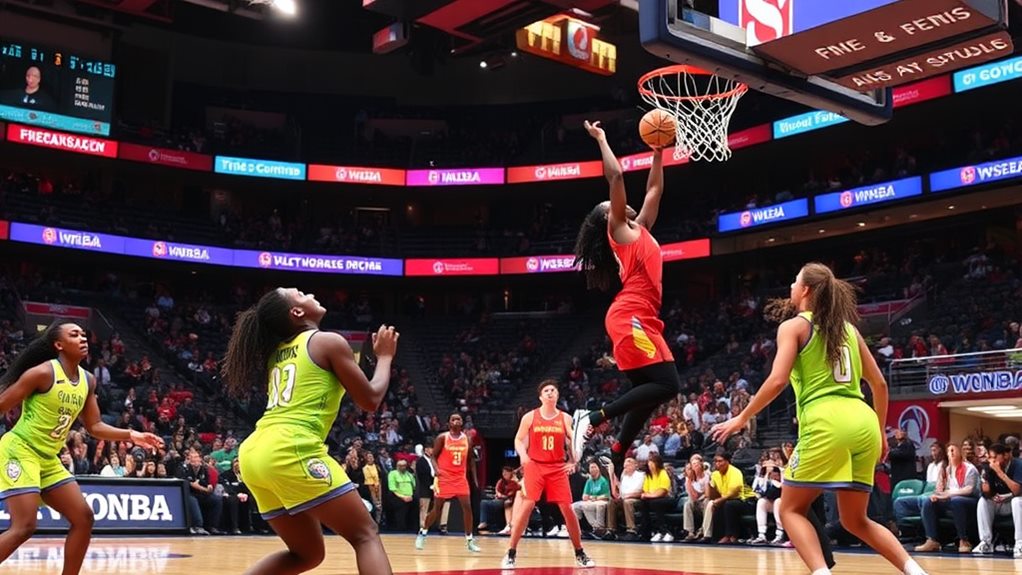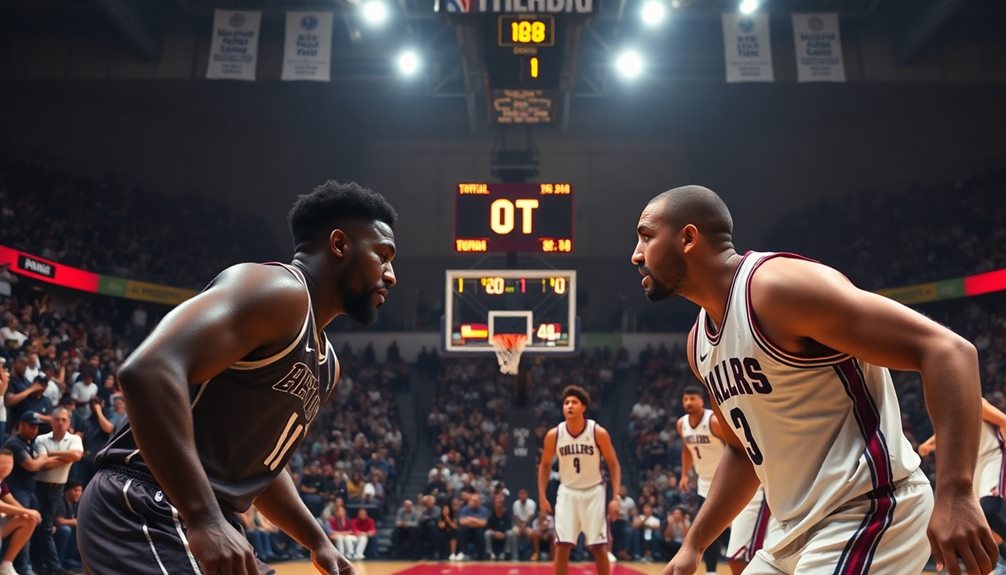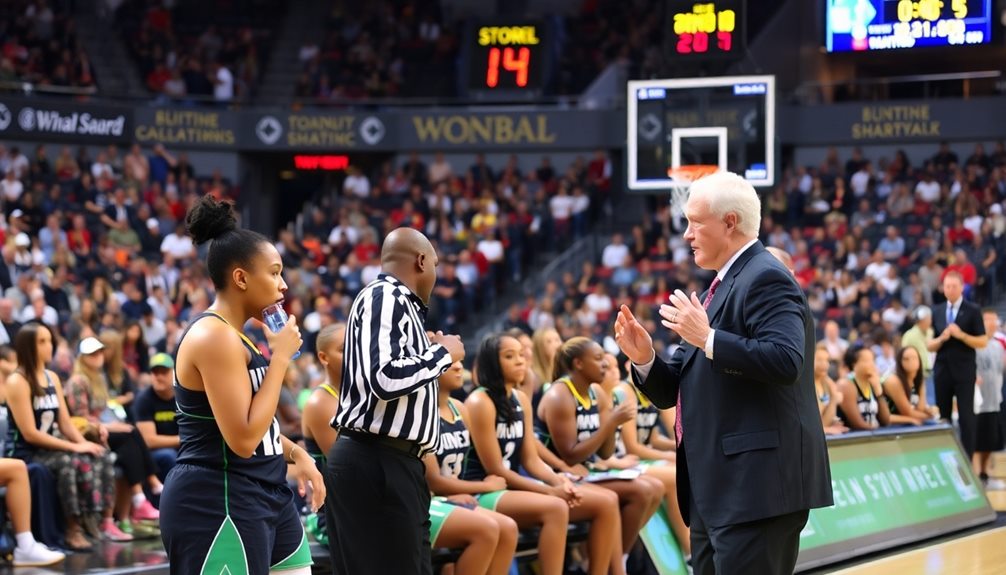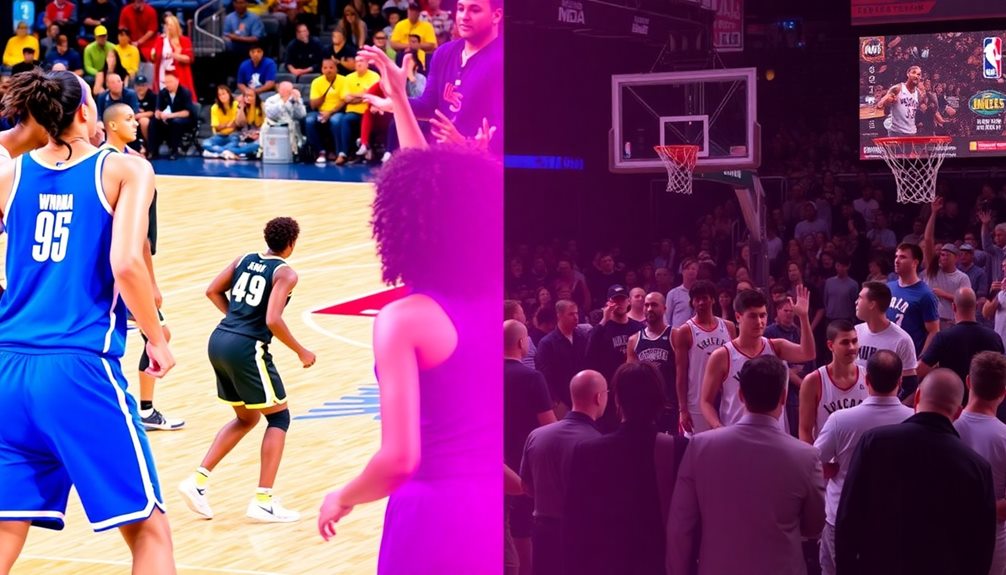
The Length of a WNBA Game: How Long Does It Last?
December 10, 2024A WNBA game lasts 40 minutes of play, divided into four 10-minute quarters. However, don't be surprised if the entire experience runs closer to two hours. Stoppages for fouls, injuries, and timeouts extend the actual game length. Each team gets four timeouts, which can heighten the tension in close games. If the score is tied, there's also the possibility of overtime, adding another five minutes to the clock. The fast-paced action keeps fans engaged, making it a thrilling event. Curious about how halftime or the atmosphere enhances the experience? There's much more to uncover!
Overview of WNBA Game Length
A WNBA game lasts a total of 40 minutes, divided into four 10-minute quarters. This game length is shorter than the NBA's, which has four 12-minute quarters. Because of this, pacing and player stamina play an essential role in how WNBA teams approach each game.
The shorter duration means players need to be strategic with their energy, pushing hard during each quarter while managing their endurance. Additionally, teams often focus on cardio workouts to enhance their performance and maintain high energy levels throughout the game.
Halftime provides an important 15 minutes for teams to regroup, rest, and refine strategies. During the game, there are stoppages for timeouts, fouls, and injuries, which can extend the overall duration beyond the standard 40 minutes. This means that while the regulation play is concise, the overall experience can last considerably longer.
If teams are tied at the end of regulation, the game goes into overtime, which lasts 5 minutes per period. This adds an exciting twist, as teams must dig deep to secure a win.
Understanding the game length and its structure helps you appreciate the tactical decisions made by players and coaches throughout the contest.
Structure of Game Quarters
Divided into four quarters, the structure of a WNBA game is designed to keep the action fast-paced and engaging. Each quarter lasts 10 minutes, totaling 40 minutes of regulation play. This shorter duration compared to the NBA's 12-minute quarters influences game pacing and player stamina, making every second count.
Understanding stoppage time can also play a role in how teams manage game flow and maintain their competitive edge.
Within each quarter, you'll notice a continuous play format, with the shot clock set to 24 seconds. This rule encourages teams to maintain a high tempo, pushing them to create scoring opportunities quickly. You'll see players working diligently to make smart plays, as the limited time forces them to be strategic with every possession.
The quarter structure also impacts how teams manage their timeouts and substitutions. Since stoppages can disrupt momentum, teams must be efficient in their use of timeouts, ensuring they don't waste precious chances to regroup.
The design of these quarters certainly requires players to adapt their roles, focusing on maximizing scoring opportunities while balancing defensive responsibilities.
Role of Overtime Periods

In the event of a tie at the end of regulation, overtime periods play an essential role in determining the winner of a WNBA game. Each overtime period lasts for 5 minutes, just like in other professional basketball leagues. This brief extension gives both teams the chance to clinch victory, adding a thrilling edge to the game.
The pressure of overtime can also influence player performance metrics, as analytics often highlight clutch situations where players excel under stress, emphasizing the significance of data-driven strategies in maximizing team efficiency.
Here's what makes overtime so impactful:
- Clutch Moments: With the clock ticking down, every shot counts, and players often shine under pressure.
- Strategic Timeouts: Each team gains one additional timeout, allowing for vital adjustments that can turn the tide.
- Unlimited Overtime: There's no cap on the number of overtime periods, meaning the game could stretch on, keeping fans on the edge of their seats.
In WNBA games, the structure of overtime mirrors that of the NBA, ensuring consistency across professional basketball.
This similarity means that players and fans alike are familiar with the high stakes and intense competition that overtime brings, making every second count as teams battle for supremacy.
Impact of Halftime Breaks
Halftime breaks play an essential role in the flow of a WNBA game, lasting 15 minutes to give teams a chance to regroup. This standardized duration is critical for player recovery and tactical discussions, as it allows both coaches and players to engage in strategic planning.
Unlike some leagues that feature extended breaks for special events, the WNBA maintains a consistent halftime break structure, which keeps the game moving smoothly. During this pivotal time, teams can analyze their first-half performance and make necessary adjustments, potentially altering the outcome of the game.
You'll often notice that both coaches and players are deeply engaged during the halftime break, discussing strategies and even reviewing plays. Additionally, these breaks aren't just for the players; they provide opportunities for fan engagement.
Halftime entertainment and activities keep spectators entertained, ensuring they remain invested in the game. As seen in various sports, the importance of halftime duration can't be understated, as it contributes considerably to team performance and game dynamics.
This structured halftime period contributes to the overall duration of a WNBA game, which typically lasts around 2 hours, including stoppages.
Timeouts and Game Stoppages

Timeouts and game stoppages play an essential role in shaping the rhythm of a WNBA game. With teams allowed four timeouts—two in the first half and three in the second—these breaks provide critical moments for strategy and regrouping. Additionally, much like the sportsmanship and respect in soccer, these timeouts encourage teams to maintain composure and focus during high-pressure situations.
However, the impact of these timeouts and stoppages extends beyond mere rest.
Consider the effects:
- Tension Builds: Late-game timeouts can heighten suspense, especially when only two can be called in the final three minutes of the fourth quarter.
- Time Out: Each timeout lasts up to 75 seconds, giving coaches time to devise last-minute plans, but it can also disrupt the momentum of the game.
- Extended Duration: Game stoppages for fouls, injuries, or video reviews can add over 15 minutes to the total game time, affecting the overall pace.
As a fan, you experience the ebb and flow of the game, where each timeout and stoppage has the power to shift momentum and alter strategies, ultimately influencing the outcome of the match. Understanding this can enhance your appreciation for the intricate dynamics at play in a WNBA game.
Factors Influencing Game Duration
When you watch a WNBA game, you'll notice that timeouts and stoppages play an essential role in how long the game lasts.
Similar to soccer, the regulations on timeouts can disrupt the flow, while fouls and injuries add extra minutes to the clock, making it vital for teams to manage these breaks effectively understanding stoppage time.
These factors combined can make the actual game duration much longer than the 40 minutes of play.
Timeout Regulations Impact Duration
The way timeout regulations are structured in the WNBA can greatly influence the overall duration of a game. With teams allotted four timeouts total—two in the first half and three in the second—these stoppages can extend the game considerably. Each timeout can last up to 75 seconds, which adds up quickly, especially in close contests where every second counts.
Consider these emotional factors:
- Tension: The strategic use of timeouts can create nail-biting moments, particularly in the final minutes of the game.
- Frustration: Frequent stoppages can disrupt your flow, making it feel like the game is dragging on longer than necessary.
- Excitement: The ability to regroup and strategize during a timeout heightens the stakes, keeping you on the edge of your seat.
Moreover, in the last three minutes of the fourth quarter, no more than two timeouts are allowed, intensifying the pressure.
While the WNBA's timeout regulations aim to enhance game flow, they can inadvertently extend the overall duration, leading to games that often exceed the standard 40 minutes.
Stoppages and Game Flow
Stoppages during a WNBA game can greatly affect its overall flow and duration, often extending the time fans spend watching. While the game consists of four 10-minute quarters, the actual duration can stretch well beyond the 40 minutes of playtime due to various stoppages.
You'll notice that timeouts are strategically used, with two allowed in the first half and three in the second, plus specific restrictions in the final three minutes of the fourth quarter. These timeouts can disrupt the rhythm and prolong the game.
Halftime adds another 15 minutes for teams to regroup and strategize, further extending the overall length. Additionally, stoppages for fouls, player injuries, and video reviews can greatly slow down the game flow, leading to additional delays that fans might find frustrating.
Even though the shot clock resets to 14 seconds after an offensive rebound to encourage faster play, teams can still face stoppages if they struggle to score quickly.
In short, while the clock ticks down, various stoppages can make a WNBA game feel longer, influencing how fans experience the excitement on the court.
Comparison to NBA Game Length

Comparing the length of WNBA games to their NBA counterparts reveals some key differences that impact gameplay. A WNBA game consists of four 10-minute quarters, totaling just 40 minutes of regulation play, while the NBA stretches to four 12-minute quarters, making it 48 minutes long.
This difference isn't just about time; it changes how teams strategize and manage their pace. The shorter game length aligns with the YMCA's emphasis on efficiency and teamwork in sports, as it encourages players to focus on strategic decision-making and collaboration.
Additionally, understanding the roots of basketball in YMCA culture helps highlight the importance of character development in shaping gameplay.
Here are three significant effects of this difference:
- Efficient Time Management: With fewer minutes, WNBA teams must optimize every possession, which leads to a more strategic and intense gameplay style.
- Player Stamina: The shorter game length affects players' endurance strategies, as they can maintain higher energy levels throughout the match.
- Timeout Structure: The WNBA allows only four timeouts compared to the NBA's seven, which means less opportunity to regroup during critical moments.
These factors create a unique atmosphere in the WNBA, forcing teams to adapt their strategies and approach to fit the shorter game structure while still engaging fans with fast-paced action.
Fan Experience During Games
When you attend a WNBA game, you'll feel the energy in the air as the fast-paced action keeps you engaged from start to finish.
The atmosphere is further enhanced by the sense of community among fans, creating connections that make each game unforgettable.
Halftime isn't just a break; it's your chance to join in on fun activities and grab some tasty food.
With exciting performances and contests during timeouts, the overall atmosphere makes every moment memorable, fostering a sense of belonging among attendees strengthens community bonds.
Game Atmosphere and Energy
The electric atmosphere of a WNBA game captivates fans from the moment they step into the arena. You can feel the energy buzzing around you, creating an unforgettable experience. The shorter game duration of 40 minutes amps up the pace, keeping you on the edge of your seat. During timeouts and breaks, the excitement doesn't dip; it only grows.
Here are three ways the game atmosphere enhances your experience:
- Interactive Activities: Join in on sponsored events like half-court shots or contests, making you feel like part of the action.
- Cheerleaders and Mascots: Enjoy engaging performances that keep the energy high, making every timeout lively and fun.
- Inclusivity: The league's commitment to accessibility guarantees everyone can enjoy the game, fostering a welcoming environment for all fans.
These elements combine to create an electric atmosphere that resonates with you long after the final buzzer.
Engaging Halftime Activities
Halftime at a WNBA game bursts with excitement, offering fans a chance to recharge while enjoying a variety of engaging activities. Lasting 15 minutes, this break isn't just for players to strategize; it's a prime time for fan engagement.
You'll often see cheerleaders performing, live music filling the arena, and interactive contests that get everyone involved. Many arenas host fan engagement events like sponsored half-court shots, where you could win cool prizes and merchandise.
These activities aren't just entertaining—they create a lively atmosphere that keeps your energy up for the second half. You might even catch a glimpse of your favorite mascot, who's there to entertain and connect with fans.
Team giveaways during halftime also enhance the experience, making you feel like part of the action. Whether it's a t-shirt toss or a chance to meet a player, these moments encourage camaraderie among fans.
Conclusion
In the world of women's basketball, a WNBA game weaves together excitement and strategy, lasting about two hours. Just like a well-tuned orchestra, the quarters, halftime, and timeouts create a rhythm that keeps you on the edge of your seat. Whether it's nail-biting finishes or thrilling overtime, each moment is a note in the symphony of the game. So, grab your popcorn and settle in; the experience is as exhilarating as a last-second buzzer-beater!


